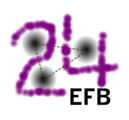Speaker
Description
Some of the interactions in nuclear systems envisage the possibility that the constituents change in intermediate states. An example is the $\Lambda-\Sigma$ coupling in hyperon-nucleon potentials or the $N-\Delta$ coupling in nucleon-nucleon potentials. The fact that the constituents change in particular their masses represent a problem for the Hyperspherical Harmonics (HH) method, since hyperspherical coordinates are generally based on mass weighted Jacobi coordinates, and in presence of those transitions the masses are no longer fixed.
We present our recent developments of the HH formalism applied to systems with particle excitations degrees of freedom.
The transformations $W$ among sets of internal coordinates with different weights are presented in detail. The representation in the HH basis of such transformations is defined in terms of an elementary set of coefficients, the $\mathcal{W}$-coefficients, representing 1-d scaling transformations in real space. Exchange operators involving different particles can also be defined in terms of such coefficients. The generator of the $W$ transformations is derived analytically and the selection rules in terms of angular and grand-angular quantum numbers are shown.
As application, separation energies of 3- and 4-body $\Lambda$-hypernuclei with a realistic $\Lambda-\Sigma$ coupling hyperon-nucleon interaction are calculated and benchmarked with results from the literature [1]. We also calculate the triton binding energy and wave function by considering the explicit $\Delta$(1232) isobar degrees of freedom and including all the NN, N$\Delta$ and $\Delta\Delta$ 2-body channels. In this last case we adopt the Argonne v28 potential [2].
[1] E. Hiyama, S. Ohnishi, B.F. Gibson and T.A. Rijken, Phys. Rev. C 89, 061302 (2014).
[2] R.B. Wiringa, R.A. Smith and T.L. Ainsworth, Phys. Rev. C 29, 1207 (1984).




